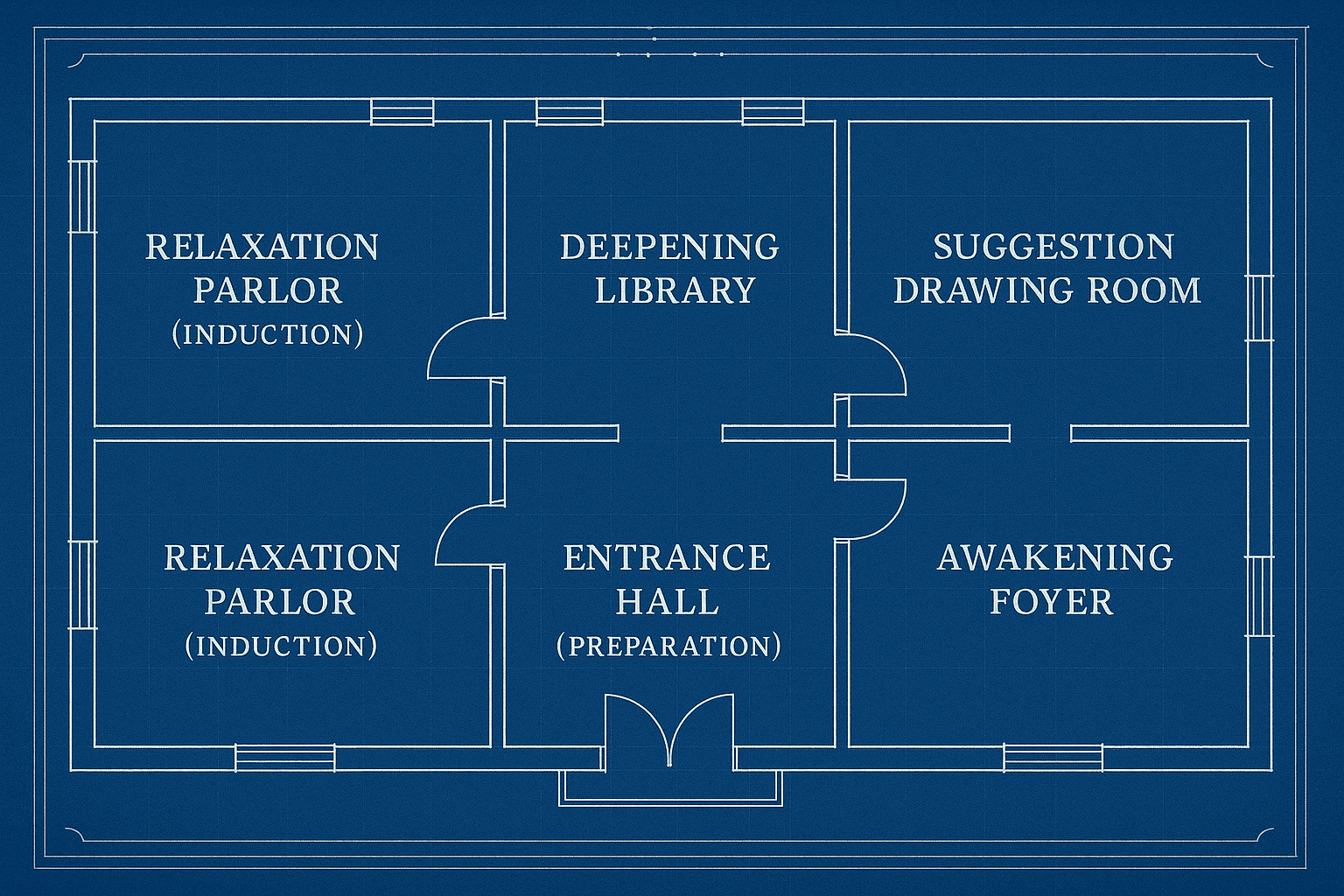
A Practitioner’s Guide to Crafting Transformational Sessions
Writing a hypnotherapy script is both an art and a science. It’s not just about relaxing your client; it’s about leading them skilfully through an inward journey that fosters real and lasting change. Whether you’re supporting someone with anxiety, confidence, pain management, or behavioural change, a well-crafted script functions as the invisible hand that gently guides the subconscious toward healing, clarity, and growth.
While every session is as unique as the client, most effective hypnotherapy scripts follow a four-stage structure that mirrors the natural rhythm of a therapeutic trance session:
- Induction
Creating the Portal: Entering the Hypnotic State
Purpose
The induction eases the client from ordinary waking consciousness into a relaxed, receptive, and inwardly focused state, often referred to as the hypnotic state or light trance. This is where the outer world begins to soften, and the inner world becomes more accessible.
Core Strategies
Progressive Muscle Relaxation
Invite attention to the body, usually from head to toe, releasing tension one muscle group at a time.
Breath Awareness
Use slow, rhythmic breathing cues to anchor the client’s awareness.
Visual and Sensory Cues
Guide them to imagine soothing scenes (floating on water, lying in sunlight, sinking into a cloud) using multisensory details, sight, sound, touch, and temperature.
Eye Fixation → Closure
A classic method: Ask the client to focus on a spot, blinking gently, until their eyes close naturally, signalling the mind’s permission to drift inward.
Example Snippet
“Take a slow breath in… and gently let it go. That’s it. Let your eyes close whenever they’re ready… and as they do, begin to notice the weight of your body supported by the chair. The ground beneath you. The air around you. You are safe. You are supported. And it’s okay now to simply let go.”
Therapeutic Tip
Keep your language permissive and inviting, rather than demanding. Words like “allow,” “begin to,” or “you may notice” signal to the subconscious that it’s safe to soften.
- Deepening
Descending into the Subconscious
Purpose
Deepening strengthens the hypnotic state, increasing the client’s receptivity and ability to absorb therapeutic suggestions. It helps move the mind from surface relaxation to deeper states of suggestibility and focus.
Core Techniques
Counting Down
The classic “10 to 1” technique, paired with progressive phrases like “deeper,” “calmer,” “still,” or “drifting.”
Descending Imagery
Visual journeys such as:
- Walking down a staircase
- Descending in an elevator
- Floating downward through clouds
- Sinking slowly into a warm bath
Fractionation
A more advanced technique: bring the client slightly out of trance (“Now take a deep breath and come up just a little…”) and then return them to a deeper state. This amplifies trance depth.
Example Snippet
“Imagine a staircase leading down… each step taking you deeper inward. With each number I count, you’ll feel calmer… more still… more connected to that quiet part within you. Ten… gentle step down… Nine… deeper now…”
Therapeutic Tip
Use rhythmic, lulling cadence. Deepening is musical, slightly hypnotic by design. Think poetry over prose.
- Therapeutic Suggestions
Delivering the Medicine
Purpose
This is the heart of the session. Here, you speak directly to the subconscious with clear, affirming, and empowering messages aligned to the client’s personal goals.
This is where ‘change’ happens.
Types of Suggestions
Direct Suggestions
Clear, present-tense affirmations.
“You feel calm and confident speaking in public.”
Indirect Suggestions
Gentle, open-ended phrasing often introduced by “perhaps,” “you may begin to notice,” or “some people find…”
“You may begin to notice how easy it feels… to speak up calmly in situations that used to feel tense…”
Metaphors and Symbolic Imagery
Storytelling can bypass conscious resistance. E.g.,
“Imagine your old patterns like autumn leaves, falling gently to the earth, clearing the space for something new to grow.”
Future Pacing
Rehearse success mentally, seeing themselves calmly navigating future situations.
“Imagine next week, walking into that room… shoulders back, breath steady… and smiling because you ‘know’ you’ve got this.”
Example Snippet
“From this moment forward, you find yourself responding differently… more calmly… more confidently… as if something within you has clicked into place. A new rhythm. A stronger you.”
Therapeutic Tip
Always speak as if the change is already happening. The subconscious mind responds to what is declared real, not what is questioned.
- Reorientation / Awakening
Integrating and Returning
Purpose
Gently bring the client back to full waking awareness, clear, refreshed, and with the therapeutic suggestions carried forward into conscious life.
Core Techniques
Counting Up
Count from 1 to 5 or 1 to 10, suggesting increased energy and clarity with each number.
Grounding Physical Awareness
Invite movement: wiggle fingers and toes, stretch the body, and take a deep breath.
Positive Reinforcement
Affirm the session’s success: “You did important work today,” “These changes are part of you now.”
Optional: Use of positive self-suggestion cues, e.g., “Each time you touch your fingers together like this, a sense of calm returns.”
Example Snippet
“In a moment, I’ll count from one to five. With each number, you’ll return feeling more awake, clear, and energised. One… slowly beginning to come back… Two… noticing the sounds around you… Three… stretching the body… Four… eyes beginning to flutter open… and Five… wide awake now, feeling calm, strong, and refreshed.”
Therapeutic Tip
Avoid abrupt awakenings. Integration matters just as much as suggestion. Let the exit be as graceful as the entrance.
Advanced Considerations
Know Your Client
The more attuned you are to the client’s values, language patterns, fears, and goals, the more powerful your script. Use their metaphors. Reflect their phrasing. Speak into their model of the world.
Calibrate Responsiveness
Watch for physical signs of trance:
- Slower breathing
- Stillness in the limbs
- Flickering eyelids
- Swallowing or facial softening
If they seem shallow, spend more time in the induction or deepening phase.
Use Strategic Silence
Silence is not the enemy; it’s a co-therapist. After key suggestions, pause. This is when the subconscious does its ‘real work.’
Mirror the Client’s Energy
Some clients respond better to metaphors, while others respond better to logic. Some need gentle reassurance, others benefit from strength and clarity. Match them.
Final Thoughts
A hypnotherapy script is not just a script; it’s a vessel for change, a carefully composed, therapeutically guided inner experience.
Let it be:
- Rhythmic like music
- Visual like a film
- Affirming like prayer
- Personal, like a story only they could write
